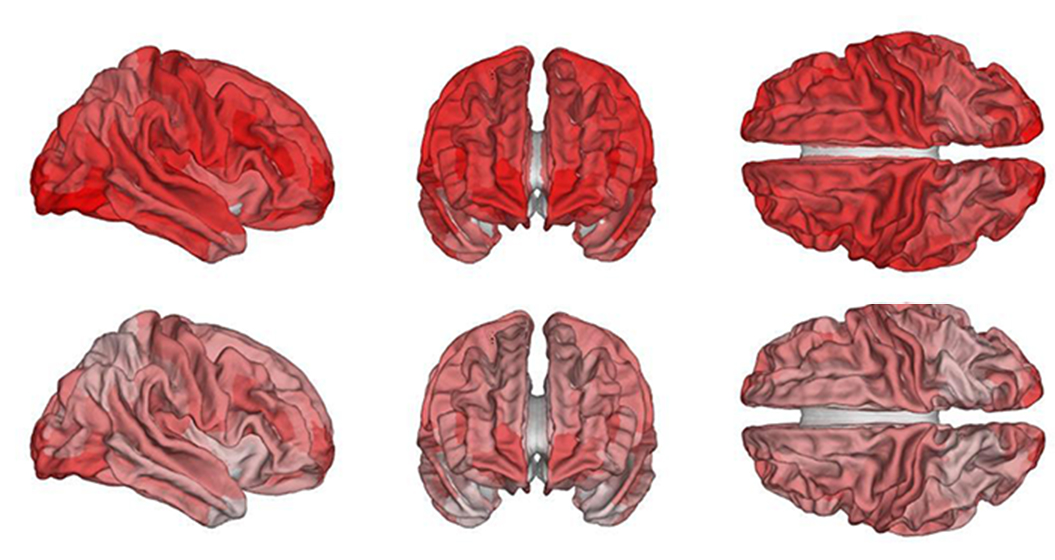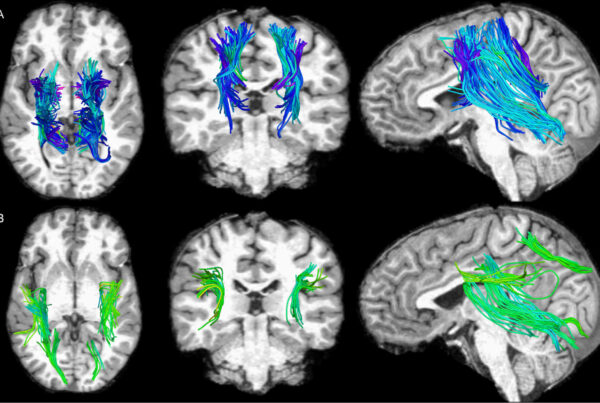The popular aphorism states that “age is just a number,” but USC Leonard Davis–led research shows how calculating the biological — as opposed to chronological — age of the brain of the brain could be a powerful tool in screening for brain health issues, including dementia, even before symptoms occur.
While chronological age increases with the passage of time, biological age doesn’t always match what’s on the calendar, says Andrei Irimia, assistant professor of gerontology, biomedical engineering, quantitative biology and neuroscience at USC. This includes the specific biological age of the brain, which, like the rest of the body, can be affected by both innate characteristics (such as genetics) and lifestyle factors (ranging from diet and exercise to substance abuse and stress).
“The concept of brain age helps us to understand and to quantify how aging occurs at different rates in different people, even though such people might be of the same chronological or calendar age,” Irimia says.
Brain injuries can have profound acute effects
Irimia’s work has demonstrated that biological brain age can vary dramatically based on whether or not an individual has suffered a traumatic brain injury (TBI). A study he published in GeroScience in July 2022 shows just how much a TBI can affect the brain’s biological age.
The study analyzed magnetic resonance imaging (MRI) data from more than 100 individuals ages 20–83 who had suffered a TBI, with scans taking place one week and six months post-injury. These scans were compared to MRI data from thousands of healthy individuals of various ages, who provided a reference for normative brain aging. The result: On average, individuals who had experienced a TBI also had a brain age that was significantly older than their calendar age.
Several signs of brain aging can be seen via MRI, Irimia explains. The model that he and his doctoral student Nahian Chowdhury used was trained on scans from more than 3,000 healthy individuals. This model can predict brain age based on brain anatomy features, including the amount of brain shrinkage, or atrophy, in different brain regions.
Not only did TBI correlate with an increase in brain age, but this increase also appeared to happen very quickly, Irimia says. Most of the gap between chronological age and biological brain age was seen during the acute phase — that is, in the days immediately following the injury — with less brain aging occurring in the period between the one-week and six-month scans.
“Whatever happens in the brain after concussion is very dynamic very early on after injury,” Irimia says. He adds that these data provide important evidence supporting what critical care neurologists and emergency room doctors have suspected for a long time: “The most critical time to act therapeutically after concussion is often very early on, because that’s when the largest changes take place.”
Older adults face particular risks
The study also illuminated how older adults who experience a TBI exhibit a greater degree of brain aging than younger TBI patients after the same period of time.
“Older adults sustaining TBIs face a significantly higher risk for having a biological brain age that’s much older than expected,” Irimia says. “On average, it turns out that an adult over 60 who sustains a mild TBI typically has a biological brain age that increases by five to 10 years as a result of their concussion, whereas younger adults exhibit a smaller gap between their chronological and biological ages.”
Older adults are at highest risk of TBI, which compounds their challenge of experiencing more injury-related brain aging than younger adults.
According to a report from the Centers for Disease Control and Prevention, adults ages 75 years and older had the highest numbers and rates of TBI-related hospitalizations and deaths in 2019, accounting for about 32% of TBI-related hospitalizations and 28% of all TBI-related deaths. Falls and motor vehicle crashes are two of the leading causes of TBI-related hospitalizations among older adults.
TBI can be particularly dangerous for older adults, especially as symptoms can be related to other conditions such as cognitive impairment, which may not be immediately identified. In addition, certain medications more likely to be prescribed to older adults, such as blood thinners, may increase the risk of brain bleeding following a TBI. Such bleeding can lead to more severe injury, or even death. Previous studies by Irimia and colleagues have shown how older age and brain bleeds are associated with greater white matter degradation and cognitive decline following a mild traumatic brain injury.
Quantifying brain aging via myelin
Another study led by Irimia, published in Frontiers in Neurology in June 2022, illustrates how damage from even a mild TBI can be mapped across the entire brain and describes a powerful new approach for quantifying brain health during aging.
The study — the first, Irimia says, to measure post-TBI demyelination noninvasively in the brains of living patients — used MRI scans to measure the amount of myelination in the brains of TBI patients. Specialized algorithms developed by the team were then used to analyze scans, quantify myelination levels, and study how these levels change over time.
Myelin is a substance that surrounds the long branches, or axons, of neurons throughout the brain and nervous system. Much like the protective sheath on an electrical wire, myelin acts as an insulator to improve the conduction of electrical signals that travel along the axons to connected cells and send messages to different regions.
“Myelination is very important because, in certain settings, it can be used as a surrogate measure of how well and how fast the exchange of information between brain areas is taking place,” Irimia explains. “On brain MRIs, myelination decreases may be an indication that the brain is aging and that communication between brain areas may be degrading.”
By examining myelin levels in both healthy individuals and TBI patients, Irimia and his team discovered that, even when mild, TBI resulted in significant demyelination, or loss of myelin, at a rate much higher than that seen in typical brain aging. The effects were seen in various regions of the brain, with some areas losing as much as 30% of their MRI-detectable myelination in the six months following an injury.
“One reason this is important is because the risk for neurodegenerative disease after TBI is paralleled by demyelination,” Irimia says. “We see this in Alzheimer’s disease, in multiple sclerosis, in Parkinson’s disease and in normal aging. The severity of myelin loss with age in certain brain regions can be a proxy for aging-related brain diseases.”
In recent years, research has continued to highlight the increased risk for dementia and other illnesses following TBIs. The ability to measure myelin levels noninvasively in patients who have experienced brain injury could provide a powerful screening tool for doctors. Such approaches could help determine who is most at risk for long-term negative effects following a concussion, even before symptoms of neurodegeneration appear.
“Our findings raise the question of whether the severity of demyelination after mild concussions could be used as a prognosticator of risk for neurodegenerative diseases after TBI,” Irimia says. “What we suspect is that the more severe the demyelination seen after TBI, the higher the risk for neurodegenerative disease.”
Identifying and addressing long-term risks
Irimia’s recent work highlights the need not only for effective brain injury prevention, but also for early detection and treatment, especially in individuals at particular risk for negative long-term consequences of TBIs.
As researchers across the world study how brains age and how to assess risk for age-related diseases and neurodegeneration, Irimia predicts that some of the most powerful tools being developed will combine personalized genetic information, such as polygenic risk scores used for Alzheimer’s disease, with detailed anatomical information that can be extracted from noninvasive brain scans. If coupled with advancing research on biomarkers and treatments for neurodegenerative diseases, the results could make a huge difference for patients.
“We will very likely have better risk assessment for disease based not just on polygenic risk score calculations but also on synergizing these with estimates of brain age, myelin content and other descriptors that could be derived from MRI,” Irimia says. “By combining all of these, we will hopefully see an improvement in estimating the risk for these diseases such that treatment and prevention can start before symptoms arise. That would be very exciting.”
Above: Myelin density, indicated here by saturation of red, is greatly decreased in TBI patients (bottom row) compared to healthy controls (top row). Image: Nahian Chowdhury, Irimia Lab





